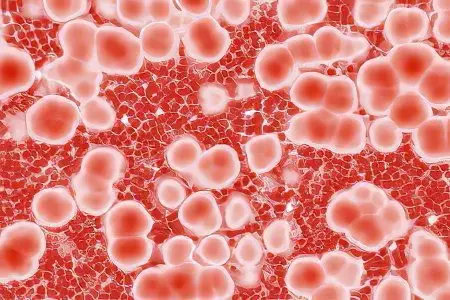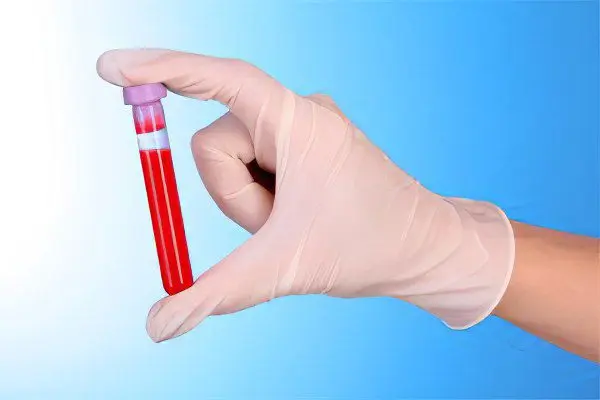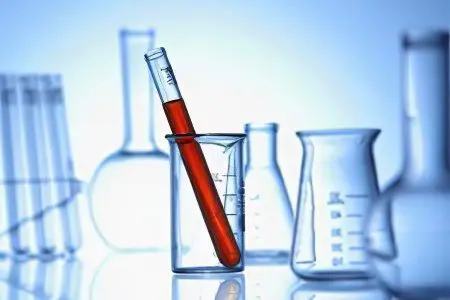What is creatinine?

Creatinine – this is one of the metabolites of biochemical reactions of amino acid-protein metabolism in the body. The formation of this compound occurs constantly and is associated with metabolic processes in muscle tissue. Since muscles constitute one of the main massifs of the human body, and contraction requires a constant energy substrate, powerful energy carriers must be laid in their structure. This is necessary in order to meet emergency energy needs.
The main donor of ATP for muscle tissue is creatine phosphate, a phosphorylated non-essential amino acid creatine. After synthesis in the liver, it enters the muscles, where it is dephosphorylated by the enzyme creatine phosphokinase. The result of these processes is the formation of energy and creatinine. ATP is consumed by the muscles to meet energy needs, and the kidneys excrete creatinine in the urine after filtration.
Creatinine norm
All creatinine cannot be filtered and excreted by the kidneys. This is due to the fact that it is constantly released into the blood while the muscle tissue is viable. Blood plasma should contain a relatively stable concentration of creatinine, which may vary depending on age, muscle activity and nutrition. Therefore, there are maximum and minimum limits for the norm of creatinine, which take into account all these points and speak of the normal functioning of organs.
To eliminate errors in the results of a biochemical blood test for creatinine levels, it is imperative to adhere to the general rules for blood sampling. The study must be carried out in the morning on an empty stomach. It is advisable to avoid strong muscle loads and overheating or hypothermia before direct blood sampling.
For clarity, the variations in creatinine standards are shown in the form of a table:
Age and gender | Small children | Pupils | Men | Women |
Norm of creatinine in µmol/l | 45-105 | 27-62 | 74-110 | 44-80 |
The norm of creatinine in women
Plasma creatinine concentration in women should be lower than in men. This is due to the physiological mechanisms of its formation, distribution and circulation in the blood.
The mechanisms behind this phenomenon are:
The muscle mass of a woman is less than that of a man;
Less muscle stress;
The activity of metabolic processes in the female body is reduced;
Food products of the female diet contain less exogenous creatinine entering the body;
Influence of sex hormones and pregnancy.
The norm of creatinine in men
The creatinine of the male body should almost always be higher than that of women of the same age group. This is due to the peculiarities of lifestyle and differences in the functioning of organs and systems. Age characteristics also affect the process of creatinine metabolism, both upward and downward. Recently, many men visit gyms and use doping containing creatine to increase muscle performance. This must be taken into account when assessing the norm of creatinine.
The norm of creatinine in children
The concentration of creatinine in the plasma of a child is more dependent on his age. The main fluctuations of this indicator are associated with growth activity and the degree of increase in muscle mass over a certain period of time. Newborns, due to the high loads that their body had to experience during childbirth, have creatinine levels the same as in adults. The same feature is typical for adolescents, which is explained by the active growth of the body. School-age children grow relatively steadily, so their creatinine levels are slightly lower than those of adults.
Elevated creatinine

When assessing creatinine metabolism, most often, one has to deal with an increase in the concentration of this metabolite. It is very important to correctly interpret the obtained indicators, taking into account the possibility of a physiological and pathological increase, age and gender standards. The condition in which an increase in plasma creatinine is recorded is called hypercreatinemia.
Hypercreatininemia does not cause severe abnormalities in the body, since creatinine itself has low toxicity. Its harmful effects on tissues can manifest themselves only with sharp deviations from the norm of its concentration. This metabolite is more related to the consequences of various conditions and diseases, signaling their presence. Therefore, isolated hypercreatininemia practically does not cause manifestations.
It is usually combined with other pathological symptoms that may suggest the need for this study:
Muscle pain;
Rapid fatigue and muscle weakness;
swelling;
Increase or sharp decrease in the amount of daily urine;
Pathological changes in the general analysis of urine (protein, leukocytes, erythrocytes).
The pathogenesis of hypercreatinemia can be associated with any of the stages of creatinine metabolism and circulation in the body. The nature of nutrition, the mode of physical activity, the amount of liquid consumed, the intake of medications, the anatomical features of the muscle tissue and its condition, the functional abilities of the excretory system and the liver are able to influence it.
What does elevated creatinine mean?
An increase in the concentration of creatinine in a biochemical blood test may indicate:
Increased intake of creatine-containing substances from the environment into the body with enhanced protein nutrition;
Excessive or very rapid increase in muscle mass;
High loads performed by the muscles;
Destruction of muscle tissue;
Redistribution of blood and violation of water balance in the body;
Impaired kidney function for the neutralization and excretion of creatinine;
Toxic effects on the body;
Endocrine disorders that regulate metabolic processes in the body.
In some cases, one has to deal with a relative increase in the level of creatinine, which is not due to its excess production or retention in the body. It is associated with a decrease in the volume of circulating plasma as a result of its redistribution, blood loss or dehydration. Relative hypercreatininemia is combined with other signs of hemoconcentration and blood clotting, which helps in its correct assessment. It never reaches high values.
Causes of increased creatinine
The immediate causes of hypercreatinemia, taking into account the severity of the increase in creatinine, are presented in the table.
Pathological causes of increased creatinine | Physiological causes of increased creatinine | |
Moderate hypercreatinemia | Severe hypercreatinemia | |
|
|
|
How to lower blood creatinine?

After a detailed examination and clarification of the cause of hypercreatinemia, the following recommendations can be given:
Hospitalization in medical institutions according to the profile in case of detection of diseases. These can be general therapeutic hospitals and specialized departments for the treatment of renal or other types of pathology;
Taking drugs to normalize protein metabolism and remove toxic products of protein metabolism;
Normalization of water metabolism by selecting the optimal volumes of fluid consumed for a particular case, taking into account the capabilities of the kidneys. If hypercreatinemia is due to physiological mechanisms, then an increase in the daily volume of pure high-quality water will lead to a decrease in the concentration of creatinine and accelerate its excretion by the kidneys;
Normalization of the diet in qualitative and quantitative terms. It involves the complete exclusion or restriction of the use of protein foods and salt, which contribute to an increase in nitrogenous compounds or retain fluid in the tissues. This, in addition to the absolute increase in creatinine, causes its relative increase due to hemoconcentration;
Correction of lifestyle and physical activity. They must be brought into line with the actual capabilities of the body. If no pathological causes of an increase in creatinine have been identified and the only option for this condition is excessive physical activity, they are minimized as much as possible;
Extracorporeal detoxification procedures (hemodialysis and its analogues). The use of an artificial kidney is advisable only in severe types of hypercreatinemia caused by decompensated renal pathology or intoxication.
Diet for high creatinine
One of the most important measures to reduce creatinine levels is diet therapy. Its general characteristics are to limit the intake of protein foods, salt and potassium, enrich the diet with antioxidants and products that cleanse the body.
Exclude:
Fatty varieties of animal and poultry meat (pork, duck, goose);
Fatty varieties of fish;
Whole milk;
Spicy dishes and spices;
Coffee and strong tea;
Dishes from rich yeast dough;
Fried foods and smoked meats.
Limited to:
Dietary meats (chicken, rabbit, turkey, young beef). You can enter meat days twice a week, when they are included in a small amount in the composition of the dishes;
Eggs – up to 2-3 per week;
Fish. Fish days are organized by analogy with meat days;
Salt and sugar. With a pronounced increase in creatinine, they are generally excluded;
Recommended:
Fresh or boiled vegetables and fruits in any quantity;
Berries, fruit drinks and compotes based on them;
Nuts and dried fruits. They are limited or completely excluded only in renal failure, when the level of potassium is sharply increased;
Dairy products (yogurt, kefir, fermented baked milk);
Cheese and cottage cheese;
Butter and vegetable oil;
Cereals and cereals based on them. Rice is especially useful in this regard;
Wholemeal bread with bran and pasta;
Honey;
Mineral and purified plain water at least one liter per day. Water loads are minimized only in renal failure.
Dishes allowed:
Boiled;
steamed;
Stewed;
In the form of soup, puree, cream soup, salad, jelly, cereal, casseroles, cutlets, meatballs;
Additional Important Recommendations: Scientific Arguments
Reduce your intake of red meat. Studies show that eating large amounts of red meat can increase creatinine levels, at least temporarily. If you eat a lot of red meat, switch to vegetable dishes. [1].
More fiber. Eating more fiber-rich foods can also help reduce creatinine. For example, a 2014 study published in the European Journal of Clinical Nutrition showed a significant reduction in creatinine levels in 143 participants with chronic kidney disease who increased their dietary fiber intake. [2]. (on the topic: fiber: benefits, types + TOP products).
Supplements with chitosan. A 2011 study published in the Journal of Pharmacy and Pharmacology examined the effects of chitosan on 80 patients with kidney failure. Half of the patients were given chitosan three times a day in tablet form, which resulted in a significant decrease in creatinine levels after 4 weeks compared with patients in the control group. [3].
Creatinine lowered

Conditions in which a decrease in plasma creatinine levels are recorded are extremely rare. Their appearance indicates a violation of metabolic processes, accompanied by profound disorders of protein metabolism in the body in general, or in isolation in muscle tissue. If hypercreatinemia mainly depends on the functional ability of the kidneys, then in the case of hypocreatinemia (decrease in creatinine), their condition does not play a role. Consequently, the main mechanism should be such a depletion of energy reserves in the body that protein resources are used to redeem them, which are most in the muscles. A decrease in creatine phosphate reserves naturally leads to a decrease in the concentration of its metabolites in the blood, which is creatinine.
Causes of low creatinine
The immediate causes of hypocreatinemia can be:
Cachexia against the background of chronic diseases and starvation;
Exhaustion of the body with a vegetarian diet or strict diets;
Weight loss due to inconsistency of physical activity with the nature of nutrition;
Muscle dystrophy against the background of their diseases;
Atrophy of large muscle masses with their disability;
Treatment with glucocorticoids;
First trimester of pregnancy.









